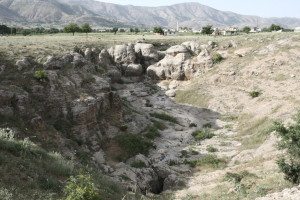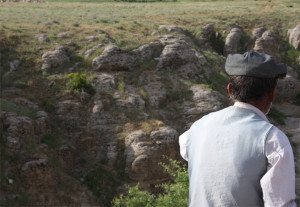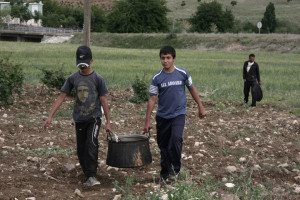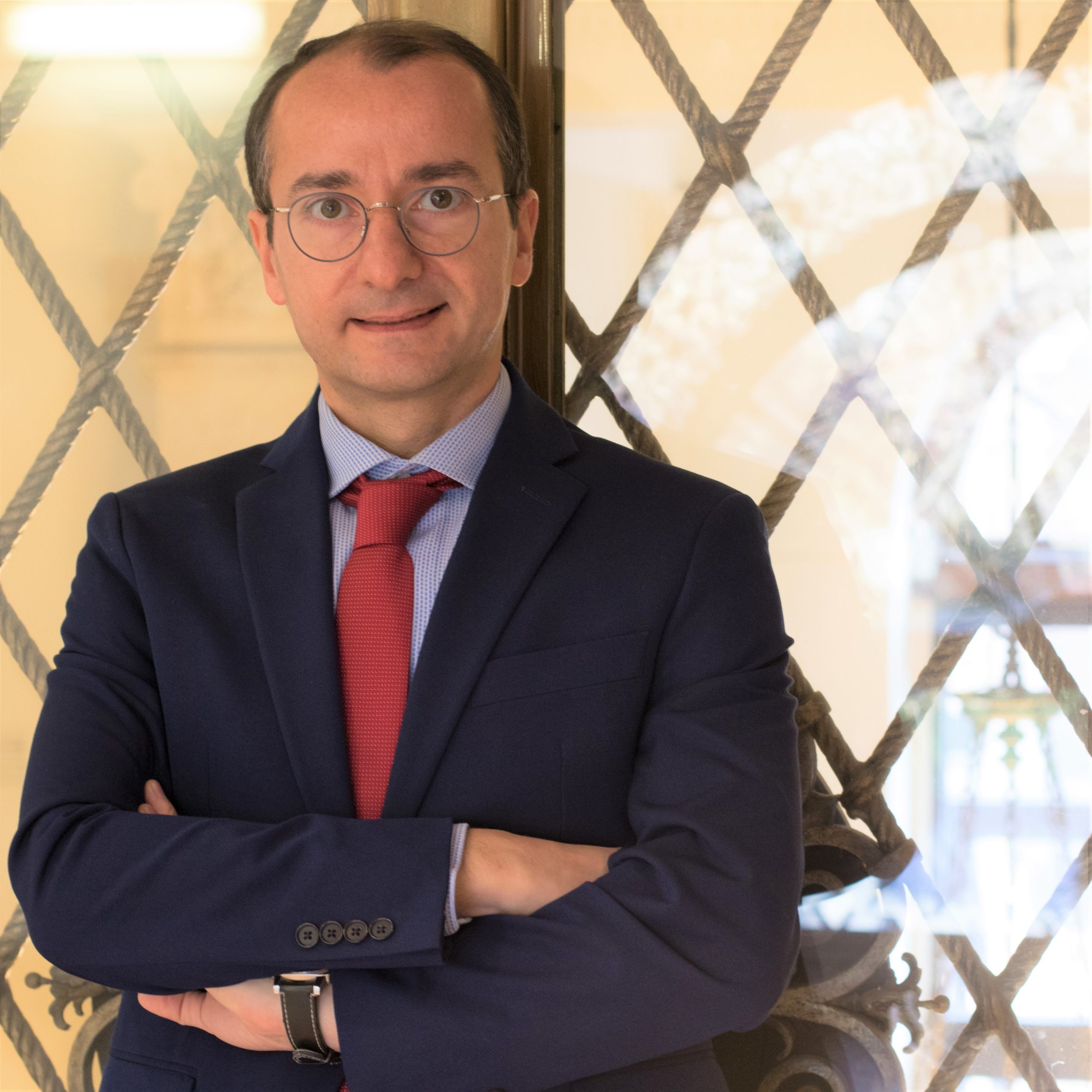“They brought the Armenians here. Thousands of them. They stripped them of their belongings and threw them into the chasm,” explains a Kurdish villager who had spotted us while driving by.

We are standing at the mouth of a deep, eerie cleft—bottomless, according to the locals—called Dudan by Armenians and Kurds for centuries (also known as Yudan Dere).
“How do you know the Armenians were killed here?” I ask.
It’s not that I’m skeptical. We know from various survivor and perpetrator accounts that the 10,000 Armenians of Chunkush (Çüngüş, a district of the province of Diyarbakir) were led here by gendarmes and armed chetes in 1915, brutally murdered, and hurled into the chasm.
“There was a woman in our village. She lived to be 104,” he replies. “She saw it all.”
He pauses. “Everybody knows.”
We had already realized that everybody knew. In Chunkush, one of the locals, a teenager, had given us directions to Dudan where, he said, the entire population of the almost exclusively Armenian village had perished.
As we were driving in that direction, we asked a man where Dudan is. He jumped into our van and led us there. When we got to Dudan, our driver, a Kurd from Diyarbakir, asked him, “What happened here?”
“Nothing,” the man murmured.
“They say something happened to the Armenians here,” the driver insisted.

***
The murder of the Armenians of Chunkush constitutes one of the largest, most brutal in situ massacres of the Armenian Genocide. The Armenians from Chunkush were marched to Dudan—only two hours away by foot—and massacred on the spot. Historian Raymond Kevorkian writes:
“The males were dealt with first, in accordance with a classic procedure: tied together in small groups of fewer than 10, they were handed over to butchers who bayoneted them or killed them with axes and then threw the bodies into the chasm. The method used on the women was quite similar, except that they were first systematically stripped and searched and then had their throats cut, after which their corpses were also thrown into the chasm. Some of them preferred to leap into the abyss themselves, dragging their children with them; thus they cheated their murderers of part of their booty.”1
In his memoir, Rev. Henry H. Riggs, an American missionary who served in Kharpert (Harput), describes Dudan as “a famous cavern [that] drops vertically downward several hundred feet.” He adds, “the entire population of the town [of Chunkush] were said to have been driven to their death in this cavern.”2
Almost no one survived. The massacre was so comprehensive that “not a single Armenian from Chunkush appeared on the bloody deportation routes…in Aleppo, Der Zor, Damascus, or any part of Arabia,” writes Karnig Kevorkian in his 600-page book on Chunkush.3

***
“This place smells of death,” says George, one of my co-travelers. “I can’t stay here any longer.” He walks towards the van, leaving me and my colleague, Nanore, behind.
I myself have never felt any closer to what can best be described as a doorway to hell. We take pictures, record a video of the site, and start surveying the area—just in case.
“The only way to get to the bottom of this is to get to the bottom of this,” I tell Nanore, and silently congratulate myself for figuring out a lame way to momentarily lighten the mood.
As we walk back, the Kurdish villager approaches me and, hesitantly, mutters: “Can I ask you something?”
“Sure!” I say, as I continue walking.
“My grandfather found a lot of items. They belonged to Armenians…”
Now he has my attention. “Go on!”
“Well, people in my village say these items were all made of gold, but that when they were found, they turned into copper.”
I am confused. “Really?”
“Yes, yes. That’s what they say. They also say that if someone can read the Armenian inscriptions on them, they will turn back to gold.”
I am dumbfounded. But I ask him to continue.
“So I was wondering,” he says, “whether you’d be willing to read them for me.”
Of all the possible responses pushing each other in my mind, trying to come out in words, I opt for the most diplomatic one. “I doubt that I have such powers, but bring them!”

The Kurdish villager takes out his cell phone and makes a call. He then asks us to get back into the van and follow him. I tell my co-travelers about our conversation.
“I really want to see what this guy has,” I say. “We’ll be careful.”
We hop into the van and follow his car. A few minutes later, he pulls up near a field. We get off, still suspicious, and wait for him to make another phone call.
After a few minutes, we see a man, a woman, and several kids with loads of utensils and copper and silver trays walking in our direction…
Notes
1- Raymond Kevorkian, The Armenian Genocide: A Complete History (New York: I.B. Tauris, 2011), 370.
2- Henry H. Riggs, Days of Tragedy in Armenia: personal experiences in Harput, 1915-1917 (Ann Arbor: Gomidas Institute, 1997), 58.
3- Karnig Kevorkian, Chunkushabadoum: Knnagan Badmutyun Hayots Chunkushi (Jerusalem: Sourp Hagopiants Printing House, 1970), 93. Pages 93-101 deal with the genocide in Chunkush.



Muradian
Next time, i am pleased that you have found a mass graves that have been preserved for almost a century. Please take a few professional mountain climbers with you and dropped them into the cave with a camera so all the people in the world can see thousands of preserved skeletons
Wow — such stubborn and persistent ignorance can only make Turks
not only evil but truly unsophisticated.
Thankfully, there are scholars and historians among Turkish society who stand on the side of Decency and TRUTH.
I personally saw that pit during in one of my visitation in Turkey.
It was an owe inspiring sight. We were told that the river Tigris was
running underneath and resurfaced some 25 miles away. I was told that the
inhabitants at that place would find small human bones, carried by the
river current.
When I was there there came some kids and threw some good size stones
in the pit and as those thrown stones would bounce between the sides of the pit
in their fall, making eery sounds eventually I would hear the splash of the
stones in the river.
John the Turk,
Just a few years back, they found a mass grave in a cave in Turkey where the villagers all knew they were the victims of the Turkish governments planned mass murders from 1915. The Turkish governmnet quickly sent the military to seal the cave and forbid any excavation or entrance by anyone to keep it quite..
That’s a fact…
john the turk,
I was going to suggest that you visit Der Zor to see the mounds of bones covered with earth, but it is inaccessible at the moment. The locals would have explained to you that the bones belong to Armenians.
john the turk,
It seems James Kizirian who posted at the same time you did appears to have some disappointing news for you. You won’t be able to find bones at the bottom. Since you are very interested in the genocide I’m sure your dissapointment is genuine (not!).
john,
Now, now, let’s not claim all the mass graves for ourselves, the Ottoman and Turkish governments did massacre non-Armenians well.
Random A,
I didn’t say they were Armenians..I said they were the victims of the Turkish Governments planned mass extermination of 1915. In fact they were most probably Assyrian victims in that cave..
john,
I know. I said it It was half in sarcasm and half in anger.
“So I was wondering,” he says, “whether you’d be willing to read them for me.”
This is so infuriating. Kurds remember what happened but then they want to loot Armenian property.
Khatchig Mouradian,
Thank you for your stories from your trips. I’ve been reading them with great interest.
Random Armenian
Please do not allow the thousands of skeletons to disappear without sending a few professionals to investigate with a camera.Do not worry about military as well as they won’t chase you for something that you simply want to dive into a cave.We will at least learn whether this river at the bottom looks like a Mississippi or Nile
James Kizirian
“We were told that the river Tigris was
running underneath and resurfaced some 25 miles away”
I have never heard that the river Tigris runs underneath. I have looked into the map to see if the river Tigris goes underneath but that doesn’t seem to be the case
Dear Khachig,
Your description is most interesting and revealing. In addition to that chasm, there are dirt-covered pits full of human (Armenian) bones, such as the one on the road from Gurun to Sevas. Excavations have not been conducted not only for validation, but for religious services in order to set the souls of the martyred to rest.
Interesting story about the gold. Gold placed next to copper changes color. It can be cleaned.
What happened next?
I wish you would publish a booklet of this story with the pictures you took. This is a fantastic story, never read one like this. Abris!
Can anyone show us where Chunkush is on google maps? I can’t find it. It’s in Diyarbakir sounds like.
I think I found it. search for Çüngüş, Turkey on google maps.
Turkish John, I agree, why won’t your Govt allow our NGO victim recovery teams into the Turkish killing fields so we can recover our dead since they were prohibited from a Christian burial by Govt decree?
Since it’s obvious we can’t get any Justice from your present Govt. all we can do is wait for a decent Govt. (or regime change) and bury our dead.
What will you say when thousands of their remains are recovered (mostly defenseless women and children) and somewhere out there, according to the Assyrians, are hundreds of thousands of their dead too who we also need to find.
As for this killing gorge, we could lower a special camera with lighting into it or send in some people who know how to explore those caverns. Can you get us permission to do that so we won’t end up in a midnight express prison for “insulting turkishness”?
We tried doing this a few years ago at another site in Turkey and your Govt ended up bulldozing the site claiming the women and children found there were “Romans”.
Thanks to the diligent scholarship of the AG by people like Mr Mouradian, the historical record has been compiled, all we need to do now is add the forensic evidence and the case is closed against Turkey. We can learn a lot more of what happened there from the victims. We might even be able to return some victims to their families through DNA.
Through forensic work, these victims will be able to “speak” and I don’t think you’re going to like what they’re going to “say” about your Country.
Why don’t you help us by getting your Govt. to allow multi-disciplined forensic teams with imaging equipment, including an airplane for covering large areas, to do their research? They can find remains through 6 feet of concrete and some of us are determined to recover those victims (and family members) including the ones at what is considered to be the largest mass-murder site on earth-Der Zor.
Ask yourself, you’re an intelligent person, why would your Govt. obstruct our victim recovery efforts if they have nothing to hide?
I have always had that deep conviction that there are many mass graves in Eastern Turkey where Armenians were concentrated.
My father described to me1992 how the gendarmes came to their village Besni and collected all the adult males including my grandfather. My father was 6 year old and he followed his father almost to the edge of the village till my grandmother collected him and they started their journey of escape. This description of lined up men came real to me when I saw the Cosovan men being lined up as prisoners… and then met their fate.
As an Electronic Engineer, I always wanted to lead a team of Armenian Archeologists, historians, journalists, lawyers and Engineers to survey Eastern Turkey for mass graves.
It requires someone to take up with the UN, USA and the EU to press for the case.
I also would like to investigate the archives of the Allied Army who took films of the world war I.
Two months ago I discussed this idea with my friend in order to raise funds.
Ground Probing Radar has been improved and also other methods … plus DNA testing… it should help in identifying Armenian bodies with accuracy.
I do not have hatred against the Turkish people as they are human beings like us. However I shall not forget what they have done neither their denial of the genocide.
There are lots of questions I like to explore.
Thank you for the article.
Dr. Manook
Thank you Khatchig Mouradian for another powerful report. As a descendant of the worthy people of Chunkoush, I appreciate your shining the light on this remarkable little town the inhabitants of which were seldom found in the death marches, as you point out, because they had been massively destroyed in their own backyard. They were shoved into a black hole of history and never became part of the count. Here is a little passage translated from Karnig Kevorkian’s book that will give those interested some idea of what Chunkoush was.
Chunkoush was located in a mountainous spot one mile east of the Euphrates, at an altitude of 4, 260 feet and northern longitude 39, eastern latitude 38. It was built on a rocky mountainside which faced east, its rows of houses connected to each other at the sides and lying one tier right on top of the other.
At present, it is an equal distance by bus ride between Dickranagerd and Kharpert, that is, a two hour trip that goes to both cities by way of Arghani, the direct road to Kharpert being too mountainous to be used by buses.
In the northern part of the valley to the east was found the stately monastery of the Merciful Mother of God. It sat on a hill and was surrounded by many prosperous farms which extended for a distance of one hour away.
The main road to Chunkoush came through the broad valley to the east and led into Chunkoush over the splendid arched bridge built over its river.
Travelers on that road could see Chunkoush from an hour away, especially at night when the twinkling lanterns of the Armenian houses, one tier above the other, gave the impression of a royal castle.
According to hallowed tradition, the ancestors of the Chunkoushtzis migrated there from the magnificent Bagratid city of Ani following the Seljuk invasion. There is reason to believe that they were tanners.
The name Chunkoush is derived from the term “shen ojakh” which means “vivacious home”, and according to a source cited by Bishop Karekin Srvantziantz [a distinguished cleric and literary figure] it is probable that the town was founded in the last quarter of the 11th century.
Powerful article. Thank you Khatchig. I was there on two occasions and the haunting memory of that chasm still resonates in my mind.
John the Turk. What a strange name! Are you a Turk (a mohammedan) and have become a christian that you call yourself “John”? After all “John” is a christian name. However; if you are so proud of your turkishness, why don’t you call yourself Mehmet Talaat?
When I was at Chinkush, we had a lady whose dad was from Chinkush. Her dad was the sole survivor of his ancestry. The reason he was survived was the fact that his father had sent him to the States (before the massacre} with the idea of later to send his brothers and the family. That day never dawned for his brothers and his family, they were all massacred with the rest of Chinkushtsis.
The Turks did a complete job of annihilating all Chinkushtsis except one lad which was thrown in the pit got somehow stuck in one of the crevices of the pit. The Turks left the area thinking that they had done a complete job, but the boy who was dangling between life and death was moaning and crying for help, a day or two later, a Kurdish shepherd was passing by and heard the cry for help and after finding the boy, he retrieved him and took him to his house. He finds out that the boy had relatives in the States. After getting in touch with his relatives, the lad was sent to them and through the testimony of this young man the whole story was revealed.
The Chinkustsi lady that was with us told us that her dad had raised a monument in the Armenian cemetery in Fresno telling the plight of the Chinkushtsis at the hand of the Turks, both in Armenian and in English. I did go there and did see the black marble monument as an historic horrific fact that took place in Chinkush.
What was that young boy’s surname, the one that survived? What is the lady’s name as well? Their names should be recounted at every telling of that story so no one has to wonder, or forget.
Thank you.
Thank you so much for the Khatchig Muradyan a very interesting article from the facts of vandalism. Thank you dear for their work, each such work – this is another in a coffin of Turkey.
We will never forget and not forgive until the last Armenian not buried in the Christian tradition. Even in the last day we will demand an answer for the innocent Armenian blood.
Dear Khatchig,
I want to thank you for going back to Western Armenia and providing feedback to all of us who have not had the time or ability to visit where our ancestors originated from.
I am especially looking forward to your report back on Kghi.
Asdvadz kezi bayeh!
Thank you for such a moving story.
I was born in çüngüş.I am living in muğla at now.this news very interesting. I know çüngüş and dudan history.If you want talk with me,I explain everything.
May I ask you to write what you know here?
Also, do you know anything of a Simon Seymour Babigan, his wife was Hamas Pamboukian or Dagdigian, unclear which. She was a widow, assuming he was killed in the Armenian genocide.
Thank you!
hi i would like to know the city/village about Besni. please if anyone knows i would like to know my grandfater was from their he servived at the time he was 7 years old.
Anni, what is your grandfather’s family name?
Someone is asking for your grandfather’s family name. Please respond as they may have or know something to share.